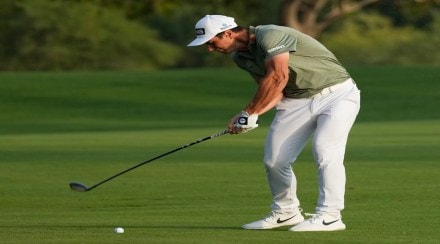The difference between the victor and the vanquished couldn’t have been starker. And it made no sense: I mean how does one of the best players of his generation, unequivocally the best driver of the golf ball and multiple Major winner, choke under pressure; and conversely, how can another, a young player, barely five years removed from his amateur days, play out of his skin when put in a high-pressure situation.
Rory McIlroy is arguably the most gifted golfer after Tiger Woods of the modern era, and he’s at his prime when it comes to his game and physical abilities. On days when his putter works—as it did during a scintillating six-under 66 second round at the Dubai Desert Classic—McIlroy makes his peers look pedestrian. But there have always been whispers about his mental fragility when put under the gun; remember the final round implosion at the 2012 Masters Tournament? Or more recently the Irishman’s meltdown at the last Ryder Cup?
There’s no question in my mind that the 3-wood which McIlroy sliced into the water on the final hole of the Abu Dhabi Classic had nothing to do with difficulty and everything to do with the situation. Tied for the lead going into the final hole—a par-5 which he had devoured under par on the previous three days—McIlroy was expected to have a chance for eagle, with a birdie almost a foregone conclusion. He ended up with a bogey and one shot out of the two-man playoff.
On the other end of the spectrum was a 24-year-old, who by all indications isn’t carrying any defeatist baggage. Viktor Hovland is, if anything, nerve-wracking to watch. The kind of player who has no understanding of risk and reward, and almost always goes for the unthinkable shots even when he doesn’t need to. And he seems to relish turning on the afterburners at the business end of tournaments. In November last year Hovland blazed to a nine-under 62 in the third round at the World Wide Technology Championship at Mayakoba and followed it up with a four-under 67 to rack up a record 23-under-par winning score. The very next month, he slammed two consecutive eagles and a birdie at last gasp to win the Hero World Challenge. And now, at the Dubai Desert Classic, Hovland blitzed two birdies and an eagle on the last three holes of the tournament and then proceeded to prevail over Richard Bland in the playoff. Golf fans the world over are taken with Hovland’s power off the tee, but it’s the way he strong-arms his way into contention that’s really quite remarkable—he makes golf an exciting spectator sport.
Talking of power and the tussle for it, there are serious machinations underway in the world’s biggest professional golf tourneys. For those who may not be following recent developments, Golf Saudi has tied up with the Asian Tour to overhaul the Tour’s schedule and significantly augment the prize money on offer. Specifically, the $10 million infusion into the Asian Tour by LIV Golf Investments will bankroll no less than 10 new events on the Tour’s 2022 schedule with purses ranging between $1.5 million and $2 million. Not surprisingly, the Asian Tour is ecstatic with the development. “I must be honest, we were pretty worried at the start of the pandemic,” Cho Minn Thant, commissioner of the Asian Tour, told Golf Digest recently. “And we’re not through that yet. But I feel like we made the most of the crisis. We figured out a way to come back stronger than before. We’re fortunate to have this opportunity, along with LIV, to elevate the tour coming out of the worst period the tour has ever faced.”
Even though there have been no official announcement yet, the grapevine is abuzz with talk of the Saudis stitching together a Super Golf League, in addition to the International Series on the Asian Tour. Needless to say, the speculation has caused much heartburn amongst the mandarins at the European and USPGA Tours who’re alarmed by the prospect of a rival world tour that could threaten their dominance in world golf. It’s worth noting that the USPGA Tour and the European Tour signed a ‘strategic alliance,’ last year to pursue mutual interests.
Those interests, it appears, need to be protected from a revitalised Asian Tour. DP World Tour chief executive, Keith Pelley, recently went as far as to say that the Asian Tour has gone from being “partners to competitors.” The deteriorating ties are a matter of concern for players on the Asian Tour, many of who also have European Tour cards. There are already indications that things could get nasty: the Asian Tour Order of Merit winner not given a spot into the Open Championship, Joohyung Kim had to play his way in with a top finish at last month’s Singapore Open. Ironically, it’s the players on the DP World Tour and USPGA Tours—the biggest stars of the game—who’re open to playing in events sponsored by Golf Saudi. The Saudi International, a standalone Asian Tour event—the final round of which is underway in Jeddah today—has attracted some of the top players in the game who have reportedly received anywhere between $1 million to $2 million in appearance money. If this is going to be a battle of purses, then my money is on the Saudis.
A golfer, Meraj Shah also writes about the game.
